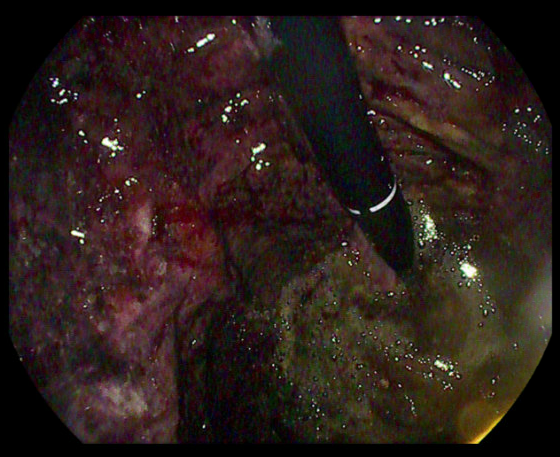Sunday Poster Session
Category: Stomach and Spleen
P2102 - Dental X-rays: A Pain in the Gut
Sunday, October 26, 2025
3:30 PM - 7:00 PM PDT
Location: Exhibit Hall
- CY
Collin York, MD
Wake Forest University School of Medicine
Winston-Salem, NC
Presenting Author(s)
Steven B. Clayton, MD, Collin York, MD
Wake Forest University School of Medicine, Winston-Salem, NC
Introduction: Acute gastric ischemia (GI) is a rare and serious condition that results from systemically reduced blood flow or vascular occlusion. Symptoms include nausea/vomiting, abdominal pain, and gastrointestinal bleeding. Prompt recognition and treatment of GI are crucial, as mortality can reach 30-40%. Here we report a case of acute GI due to atherosclerotic disease and orthostatic hypotension that resolved with supportive treatments.
Case Description/
Methods: A 66-year-old man with a history of end-stage renal disease on dialysis, diabetes, hyperlipidemia, and ulcerative colitis status-post colectomy presented to a university medical center with weakness and right shoulder pain. He was found to have a neck abscess and bacteremia and underwent incision and drainage. He was found to have superior vena cava septic thrombophlebitis and started on therapeutic anticoagulation. After moving from lying to standing for a dental x-ray, the patient developed acute epigastric pain, syncopized, and then vomited 100 cc of blood. Anticoagulation was held, and he underwent esophagogastroduodenoscopy (EGD). EGD showed black mucosa involving the entire greater curvature of the stomach with diffuse oozing of blood. CT angiogram showed gastric emphysema involving the fundus and proximal gastric body, high grade stenosis of the celiac trunk, and patent inferior mesenteric artery with moderate stenosis. The patient was treated non-operatively with a proton pump inhibitor and fluid resuscitation, with resolution of pain and no recurrence of bleeding. Biopsies showed gastric tissue with hemorrhage and reactive change, consistent with ischemia.
Discussion: In our case, GI likely resulted from a combination of underlying atherosclerosis, systemic infection, and orthostasis. Although GI is infrequently reported in the medical literature, its true prevalence may be underrecognized. In cases of suspected gastric ischemia, prompt endoscopic evaluation and tissue biopsy are crucial for confirming the diagnosis and guiding subsequent steps in management.

Figure: Gastric ischemia, stomach
Disclosures:
Steven Clayton indicated no relevant financial relationships.
Collin York indicated no relevant financial relationships.
Steven B. Clayton, MD, Collin York, MD. P2102 - Dental X-rays: A Pain in the Gut, ACG 2025 Annual Scientific Meeting Abstracts. Phoenix, AZ: American College of Gastroenterology.
Wake Forest University School of Medicine, Winston-Salem, NC
Introduction: Acute gastric ischemia (GI) is a rare and serious condition that results from systemically reduced blood flow or vascular occlusion. Symptoms include nausea/vomiting, abdominal pain, and gastrointestinal bleeding. Prompt recognition and treatment of GI are crucial, as mortality can reach 30-40%. Here we report a case of acute GI due to atherosclerotic disease and orthostatic hypotension that resolved with supportive treatments.
Case Description/
Methods: A 66-year-old man with a history of end-stage renal disease on dialysis, diabetes, hyperlipidemia, and ulcerative colitis status-post colectomy presented to a university medical center with weakness and right shoulder pain. He was found to have a neck abscess and bacteremia and underwent incision and drainage. He was found to have superior vena cava septic thrombophlebitis and started on therapeutic anticoagulation. After moving from lying to standing for a dental x-ray, the patient developed acute epigastric pain, syncopized, and then vomited 100 cc of blood. Anticoagulation was held, and he underwent esophagogastroduodenoscopy (EGD). EGD showed black mucosa involving the entire greater curvature of the stomach with diffuse oozing of blood. CT angiogram showed gastric emphysema involving the fundus and proximal gastric body, high grade stenosis of the celiac trunk, and patent inferior mesenteric artery with moderate stenosis. The patient was treated non-operatively with a proton pump inhibitor and fluid resuscitation, with resolution of pain and no recurrence of bleeding. Biopsies showed gastric tissue with hemorrhage and reactive change, consistent with ischemia.
Discussion: In our case, GI likely resulted from a combination of underlying atherosclerosis, systemic infection, and orthostasis. Although GI is infrequently reported in the medical literature, its true prevalence may be underrecognized. In cases of suspected gastric ischemia, prompt endoscopic evaluation and tissue biopsy are crucial for confirming the diagnosis and guiding subsequent steps in management.

Figure: Gastric ischemia, stomach
Disclosures:
Steven Clayton indicated no relevant financial relationships.
Collin York indicated no relevant financial relationships.
Steven B. Clayton, MD, Collin York, MD. P2102 - Dental X-rays: A Pain in the Gut, ACG 2025 Annual Scientific Meeting Abstracts. Phoenix, AZ: American College of Gastroenterology.
